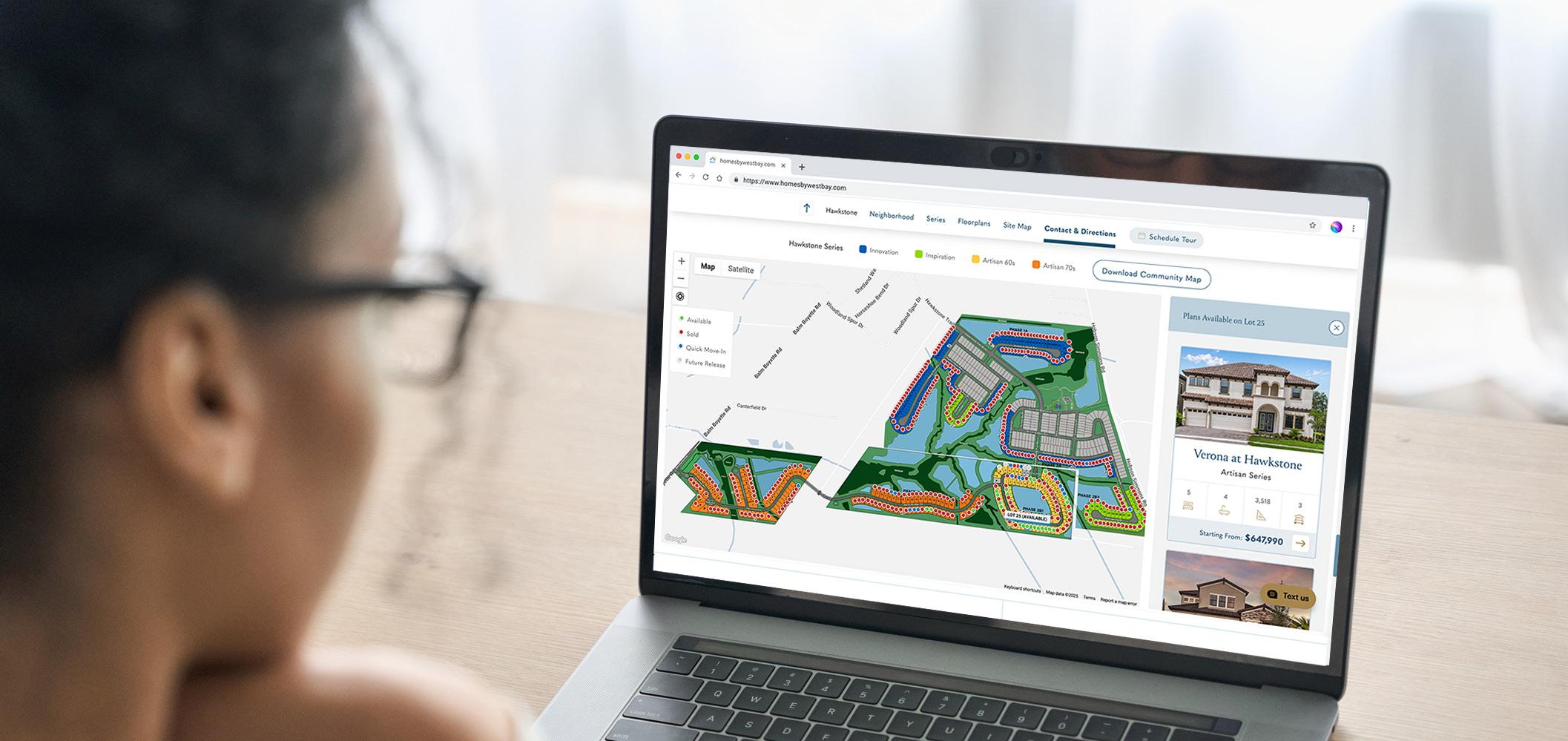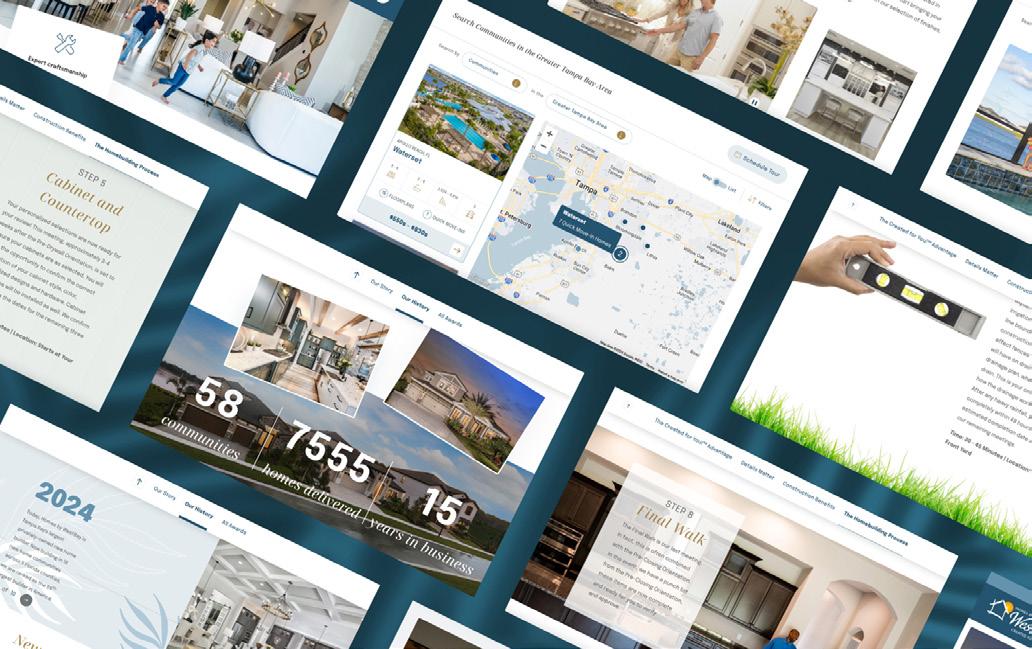

Home Builder Digital Trends Report

IntroductionGraphic Language is a dynamic web design and digital marketing agency that has carved a niche in the homebuilding industry. With a mission deeply rooted in innovation, we take pride in creating digital solutions that drive results. Our team of creative professionals is dedicated to designing engaging websites, executing strategic marketing campaigns, and providing a suite of services that enhance online visibility and sales for home builders.
We’re drawing on our experience in the homebuilding industry to share invaluable insights to help home builder marketers bolster their digital initiatives. Our goal is leverage our expertise and findings to help guide your digital strategy so you can turn prospects into buyers.
Contributors: Chris Ochs, Brea Buffaloe, Teana Halford
Copyright © 2025 by Graphic Language, Inc. All rights reserved. No part of this publication may be reproduced, distributed, or transmitted in any form or by any means without the prior written permission of Graphic Language, Inc.

GL Product Spotlight
Introducing: SPOTTM Maps
Digital Marketing Strategies
Marketing Strategies During Uncertain Times
Organic Search Strategies
Voice Search Optimization
Website Design Strategies
Common Website Design Mistakes Homebuilders Should Avoid

GL Product Spotlight
Introducing SPOT TM Maps
Revolutionizing Plat Mapping Technology
Homebuilders, say goodbye to the frustrating and outdated process of managing lot maps. We are proud to announce the launch of SPOT™ Maps (Single Point of Transaction) – an innovative solution designed to simplify lot mapping, save time and money, and create a better experience for homebuyers. Whether you’re a communitybased builder or work with scattered lot developments, SPOT™ Maps is here to streamline your operations and enhance the home-buying journey.
Traditionally, creating and maintaining lot maps has been a complex and costly endeavor. Many builders resort to uploading static graphic files, leading to a clunky, uninspiring experience for buyers. With SPOT™ Maps, we’ve transformed this process to benefit both builders and buyers, offering a dynamic, user-friendly solution powered by advanced mapping technology.
Why SPOTTM Maps is a Game-Changer
SPOT™ Maps allows builders to overlay their custom lot graphics onto popular mapping technologies like Google Maps and Mapbox. This intuitive platform dynamically displays lots, lot data, and available home types, all while delivering real-time updates on status, pricing, floorplans, photos, and videos. The result? A seamless experience that keeps buyers informed and engaged.


What Makes SPOTTM Maps Stand Out
• Intuitive Setup: Integrate SPOT™ Maps effortlessly, without the need for technical expertise or lengthy implementation processes.
• Map Overlay Technology: Combine your lot graphics with real-world mapping for clear and contextualized information on lot locations.
• Real-Time Updates: Provide buyers with up-to-the-minute details on lot availability, prices, floorplans, and multimedia content.
• Customizable Views: Highlight key details such as local amenities, home statuses, and more, tailoring the experience for individual buyer preferences.
• Streamlined Transactions: Buyers can now reserve or purchase a lot and home online directly from the map, making the process quick and easy.
• Integrated Listings Search: For those who prefer a traditional approach, we’ve added a powerful listings search linked to the SPOT™ Map for detailed property browsing.
• Seamless Website Integration: Embed SPOT™ Maps directly into your website for a cohesive and professional user experience.
• ERP System Compatibility: Sync with your enterprise resource planning (ERP) software for efficient operations and reduced manual updates.
• Brand Alignment: Customize SPOT™ Maps to reflect your brand identity and provide a consistent look and feel.
• Affordable Pricing: Access cutting-edge technology without breaking the bank, ensuring value for builders of all sizes.

Benefits for Builders and Buyers
For builders, SPOT™ Maps offers a time-saving, cost-effective way to manage lot maps while improving operational efficiency. For buyers, it delivers a visually appealing and transparent experience, allowing them to explore new home locations, check real-time availability, and view detailed pricing and floorplans—all from their devices.
By simplifying the mapping process and reducing costs, SPOT™ Maps empowers builders to focus on what matters most: creating homes and generating leads. At the same time, buyers enjoy a more intuitive and engaging journey as they find their perfect home.
See SPOTTM Maps in Action
SPOT™ Maps is designed to help homebuilders work smarter, not harder. Whether you’re navigating the challenges of a large community project or managing scattered lots, this platform is your next essential tool for success.
Don’t just take our word for it! Experience the power of SPOT™ Maps firsthand. Contact Graphic Language today to schedule a demo and discover how SPOT™ Maps can reshape the way you manage lot maps and connect with homebuyers. Together, let’s lead the way in modernizing lot mapping for the future.

Digital Marketing Strategies
Adapt to Change: Marketing Strategies During Uncertain Times
How can home builders thrive in an uncertain economy? The answer lies in adaptability, innovation, and understanding consumer needs.
Few industries experience the impact of economic uncertainty quite like home construction. Shifting market conditions bring challenges ranging from rising material costs and fluctuating interest rates to increased consumer hesitation. However, within every market downturn lies a significant opportunity for builders prepared to innovate and for marketers capable of adapting their strategies effectively.
Here’s how home builders can adapt and succeed by using new, consumer-focused approaches to connect with buyers, even during uncertain times.
The State of the Housing Market Today
The housing market is going through some big changes right now, bringing challenges that are testing the industry’s ability to adapt. Builders are dealing with higher costs for materials like lumber and steel, thanks to tariffs and supply chain issues. On top of that, rising mortgage rates and home prices are making homes less affordable, which is putting even more pressure on the market.

At the same time, buyer preferences are shifting. Millennials, Gen Z, multicultural households, and single women are becoming key players in the market, each with their own unique needs and priorities. So, how can builders not just keep up, but actually thrive in this environment?
The answer is simple: embrace flexible, data-driven marketing strategies that connect with today’s diverse buyers. With the right approach, builders can adapt to these shifts and come out ahead
Key Marketing Strategies for Home Builders
Here are six key strategies homebuilders can use to stay competitive, connect with buyers, and highlight what makes their homes stand out.
1. Leverage Data-Driven Decision Making
Understanding buyer preferences is crucial for success in today’s market. Homebuilders can no longer depend solely on intuition; real-time insights into consumer behavior are now essential. By utilizing analytics, you can identify trends and gain a deeper understanding of buyer behaviors, preferences, and pain points.
Know Your Buyers: Millennials and Gen Z are influential demographics in the real estate market, each with distinct preferences. Millennials prioritize eco-friendly, affordable homes with personalized touches. They are particularly attracted to properties featuring sustainable designs, energy-efficient systems, and spaces tailored to their lifestyles. Gen Z, on the other hand, values transparency, ethical practices, and functional, practical living spaces. They seek innovative layouts and technology-enhanced homes that reflect their eco-conscious priorities.

Targeted Marketing Strategies: Leverage advanced analytics to track buyer preferences and design targeted campaigns emphasizing affordability, energy efficiency, and modern technology. Platforms like Instagram and TikTok are highly effective for showcasing visually compelling content, including video walkthroughs, virtual open houses, and 3D property renderings. Well-crafted, personalized digital ads can establish stronger connections with your audience, increasing the likelihood of converting engagement into leads.
Engaging Interactive Content: Tools such as virtual tours and 3D renderings provide buyers with a realistic, immersive experience of your properties from the comfort of their homes. Highlighting eco-friendly features through videos or infographics can appeal to younger, tech-savvy buyers. These tools not only showcase the unique qualities of your listings but also help build trust, excitement, and stronger emotional connections with your audience.
2. Customer-Centric Campaigns Build Trust
Homebuyers are seeking more than just properties; they’re looking for a trusted partner in their home-buying journey. Address their concerns and emphasize clear benefits through customer-centric marketing strategies.
Maintain Transparency: Clearly outline each step of the home-buying process, including pricing, timelines, and details regarding construction or renovations. Be upfront about potential challenges, such as affordability or delays, and provide actionable solutions to help buyers navigate these issues with confidence. Transparency fosters trust and ensures buyers remain well-informed throughout their journey.
Leverage Real Stories and Testimonials: Build credibility by showcasing genuine success stories from satisfied buyers. Share detailed testimonials that highlight how clients achieved their goals of finding their ideal homes, even in today’s competitive market. Demonstrate how your services played a key role in their success, helping to inspire confidence and establish an emotional connection with prospective buyers.
Integrate Chatbots: Enhance your website’s functionality by incorporating chatbots to provide 24/7 support. These tools can rapidly address common questions regarding pricing, availability, or financing while directing users to additional resources or live support for more complex matters. Chatbots offer a seamless, responsive experience that ensures buyers receive timely assistance.
3. Streamline Your Digital Presence
Digitally savvy buyers now expect seamless online experiences throughout their home-buying journey. A strong digital presence is no longer optional; it is essential. With the majority of homebuyers beginning their search online, your website should serve as a powerful gateway to your brand.

Interactive Features: Enhance buyer engagement with tools that personalize and streamline the home-buying journey. Incorporate features such as mortgage calculators to estimate costs, customizable home design platforms for visualizing upgrades, and augmented reality (AR) for virtual property tours. These tools not only elevate the user experience but also foster trust by helping buyers envision themselves in your properties.
SEO and Paid Ads: Boost your online presence and attract qualified leads through strategic SEO and targeted advertising. Optimize your website for relevant search terms such as “energy-efficient homes” or “affordable homes near me.” Complement this with paid advertising campaigns to reach users actively seeking properties. Prioritize high-intent keywords and continuously refine your campaigns to connect with the right audience at the right time.
4. Adaptability is Key
Adaptability is essential when navigating the complexities of a fluctuating housing market. Continuously refining your campaigns in response to market dynamics ensures your messaging stays relevant and effective.
Monitor Consumer Behavior: Leverage real-time data analytics to analyze consumer habits and preferences. Adapt offerings and tailor messaging to align with evolving economic conditions and market trends. This approach helps maintain a competitive edge while ensuring you meet buyer expectations effectively.
Limited-Time Offers: Create a sense of urgency with time-sensitive incentives such as rate buydowns, discounted upgrades, or flexible construction timelines. Clearly emphasize the value of these offers, demonstrating to potential buyers how they can save money or gain additional benefits by acting promptly.
Incorporating real-time dashboards can enhance campaign tracking and streamline decision-making processes, ensuring greater precision and efficiency.
5. Collaborate with Strategic Partners
Partnering with established local businesses, real estate professionals, or social media influencers is an effective strategy to expand your reach and foster trust within your community. Building these collaborations not only enhances your credibility but also opens the door to valuable engagement and growth opportunities.
Real Estate Agents and Influencers: Partnering with local real estate agents gives you access to their networks and expertise, positioning your brand as a trusted resource for buyers and sellers. Collaborating with social media influencers with a strong local presence can also amplify your message, showcase your services, and generate quality leads through authentic content. Co-hosted events, property showcases, or featured posts can greatly increase your visibility.

Community Initiatives: Engaging in community initiatives builds goodwill and shared purpose. Sponsor or participate in projects like sustainable homes, local cleanups, or creating green spaces. These efforts show your commitment to the neighborhood and help connect with clients who share your vision for a better community.
6. Build Brand Stability and Confidence
During times of economic uncertainty, buyers seek reassurance. By emphasizing your company’s stability and the long-term advantages of new construction homes, you can foster trust and confidence in their decision-making process. Buyers are more likely to commit when they recognize the quality, reliability, and durability in both the homes and the company supporting them.
Highlight the Value: Communicate the benefits of new construction homes, such as builder-backed warranties that provide peace of mind, energy efficiency that reduces utility costs, and lower maintenance expenses compared to older properties. By demonstrating how these advantages outweigh the higher initial investment, you can help buyers see the long-term value in their purchase.
Promote Company Stability: Showcase your company’s proven track record of reliability and resilience. Share success stories, industry awards, and years of experience to position your brand as a trusted and dependable partner in homeownership. A stable and reputable company instills greater confidence in buyers, encouraging them to move forward with their investment.
Looking Ahead: The Future of Homebuilder Marketing
The future belongs to builders who can innovate and adapt quickly to shifting industry demands. To maintain a competitive edge in emerging markets, it is crucial to adopt advanced strategies and technologies:
AI-Driven Insights: Leverage AI technologies to streamline operations and enhance efficiency. Automating marketing workflows can significantly save time, while personalizing buyer experiences fosters stronger connections with target audiences, improving engagement and conversions.
AR/VR Immersive Experiences: Invest in AR/VR tools to offer potential buyers an enhanced virtual experience. These technologies allow individuals to explore properties remotely, providing an immersive way to visualize homes and enabling them to make informed decisions before an on-site visit.
Predictive Models for Market Trends: Adopt predictive modeling tools to anticipate market trends with greater accuracy. By analyzing buyer behavior, economic shifts, and housing demands, these tools help builders make data-driven decisions, minimize risks, and strategically allocate resources.

Embracing Flexibility: Flexibility is essential in today’s dynamic market. Rising interest rates and affordability pressures require a focus on designing smaller, energy-efficient homes tailored to the preferences of Millennials and Gen Z buyers. This approach ensures competitiveness and aligns with the evolving needs of these demographics.
By integrating these strategies, builders can establish a foundation for long-term success while delivering innovative, efficient, and customized solutions that meet the expectations of modern homebuyers.
Adapt and Lead with Confidence
Now, more than ever, it’s essential for home builders to remain flexible, consumer-focused, and adept at harnessing analytics and technology to fine-tune their marketing strategies. Those who innovate during uncertain times won’t just survive; they’ll thrive.
Want to bring these concepts to life for your company? Contact us today for a custom marketing strategy consultation. We’ll help you navigate uncertainty and build toward long-term success.

Organic Search Strategies
Voice Search Optimization:
Adapting Your SEO Strategy for AI
The way people search for information is changing, and voice search is at the forefront of this shift. Voice search technology, powered by AI, has made it easier than ever for users to find what they need by simply speaking into their devices. For homebuilders, this shift represents a unique opportunity to reach new clients, but only if their SEO strategies are optimized for voice search.
Whether your potential customers are asking their smart speakers, “Where can I find new build homes near me?” or performing a voice command on their phones, voice search has fundamentally changed how businesses are discovered online. Let’s explore how homebuilders can adapt their SEO strategies to align with these innovations, ensuring your brand stands out in the rising tide of voice queries.
What is Voice Search and Why Does it Matter?
Voice search differs significantly from traditional text-based search. Instead of typing keywords into a search engine, users now speak their queries aloud to virtual assistants. This shift has transformed the way people phrase searches, making them longer and more conversational.
Voice Search Statistics
The growth of voice search is undeniable:
• Over 40% of adults now use voice search daily.

• By 2024, the number of voice-enabled digital assistants is predicted to surpass 8 billion devices globally.
• More than 58% of consumers use voice search to find local businesses in the United States.
This surge in voice search reflects a fundamental change in user behavior, driven by convenience and advancements in AI technology. Homebuilders who adapt to these trends can position themselves as leaders in their local markets.
The Impact of Voice Search on Homebuilder SEO
For homebuilders, voice search presents a game-changing opportunity. Think about it; when someone is in the early phases of exploring their dream home, they’re likely to use local, conversational phrases such as “Who builds new homes near me?,” “Top-rated homebuilders in [city],” or “What’s the cost of building a two-story house?”
Voice search technology is tailored to these kinds of queries, making local SEO and conversational content essential for visibility in search results. Search engines like Google prioritize direct, concise answers that align with these queries. AI technology has also enabled search engines to better understand user intent, offering more accurate results for voice commands.
For homebuilders, this evolution demands a strategic pivot. If your website isn’t optimized for voice queries, you risk fading into the background as competitors dominate voice-specific search results.
Key Strategies for Voice Search Optimization
Implementing voice search optimization doesn’t have to be overwhelming. Homebuilders can boost their visibility for AI-driven voice commands by focusing on a few key areas.
1. Use Long-Tail Keywords
Voice search thrives on specificity. Instead of targeting generic terms like “Austin homebuilders,” focus on longtail keywords that match conversational phrases. Use tools like Ubersuggest or AnswerThePublic to find long-tail keywords that align with questions customers may ask. To adapt your SEO strategy:
• Identify common questions clients ask about your services.
• Include long-tail keywords like “affordable custom homebuilders near Dallas.”
• Use question phrases such as “How long does it take to build a home?” or “How do I choose the right homebuilder?”

Consider the types of questions your potential clients might ask when shopping for their dream home, and incorporate these phrases into your content.
2. Optimize Content for Conversational Queries
Voice search queries are more conversational than text-based searches, so you should structure your content to take advantage. Think about how buyers search. Here are some ways to optimize your content for these queries:
• Writing content in a Q&A format to directly address common customer queries.
• Creating blog posts that answer frequently asked questions homebuyers might have, such as “What are the first steps to building a new home?”
• Using an approachable tone that matches how potential customers naturally communicate.
• Add an FAQ section to your website that directly answers the commonly asked questions from potential buyers.
Also, incorporate structured data (schema markup) to highlight important information like your business name, address, services, and operating hours, making it more likely to surface in voice results.
3. Local SEO for Homebuilders
Voice search has a strong local focus. A significant number of voice queries include phrases like “near me” or are locationspecific. For homebuilders, this is a golden opportunity to attract nearby buyers. Here’s how to win with local SEO:

• Claim and Optimize Your Google My Business Listing: Ensure your Google My Business profile is up-todate with correct contact information, operating hours, and images of your work. Including client reviews can also enhance credibility.
• Use Local Keywords: Integrate location-based keywords into your content, such as “luxury homebuilder in Austin” or “new build homes New York.”
• Encourage Customer Reviews: Positive reviews on platforms like Google, Yelp, and Facebook not only improve trust but also help your business rank better in local voice search results.

4. Technical Optimization for Voice Search
No matter how great your content is, a slow or poorly designed website will cripple your SEO efforts. Voice search prioritizes sites that are fast and mobile-friendly. Here’s how to ensure your website meets the technical requirements:
• Improve Page Speed: Compress images, enable caching, and minimize page load times.
• Make It Mobile-Friendly: Most voice searches happen on mobile devices so your website must be responsive and easy to navigate on smaller screens.
• Secure Your Site with HTTPS, as search engines prioritize secure websites.
• Optimize for Snippets: Featured snippets (the concise, highlighted answers at the top of search results) are critical for voice search. Format your answers clearly with proper headings, lists, or bullet points to improve your chances of landing in this coveted spot.
Tools and Resources for Implementing Voice Search Optimization
Adapting to voice search doesn’t mean going it alone. Several tools can streamline the optimization process for homebuilders:
• Google Analytics and Search Console: Monitor which keywords (or phrases) drive traffic to your site and adjust accordingly.
• AnswerThePublic: Generate questions users commonly ask about specific keywords, helping you brainstorm blog ideas or FAQ content that could rank in voice search.
• BrightLocal: Manage local SEO efforts, including your Google Business Profile updates.
• Semrush or Ahrefs: Both tools allow you to track keyword rankings, discover long-tail opportunities, and audit your site for on-page optimization related to voice search.
• Yoast SEO or Rank Math (WordPress Plugins): Simplify implementing schema markup and optimizing for conversational keywords.
Keep Your SEO Future-Proof
Voice search isn’t just a trend; it’s reshaping how potential customers find and interact with businesses. For homebuilders, optimizing for voice search means more than just improving rankings; it’s about creating memorable, personalized experiences for buyers starting their homebuilding journeys.

Website Design Strategies
Common Website Design Mistakes Homebuilders Should Avoid
A well-designed website is more than just a digital presence for homebuilders. It’s a marketing powerhouse, attracting leads and converting visitors into buyers. However, even the most beautifully designed websites can fail if they miss basic but crucial principles.
Research shows that 94% of online users form an opinion about a website within seconds of viewing its design, and this perception can make or break their decision to stay or leave. Let’s shine a light on the common web design mistakes that can hurt your online success and explain exactly how to avoid them so your website doesn’t just look great but also performs well.
Mistake 1: Not Prioritizing Accessibility
Making your website accessible means everyone, including people with disabilities, can easily use and enjoy your content. Did you know that over 80% of homepages have at least one accessibility issue, according to the 2022 WebAIM Million Report? That’s a huge chunk of your audience potentially left out. And it’s not just about being inclusive; accessibility is also a legal must in many places, like under the Americans with Disabilities Act (ADA) in the U.S.
Easy Ways to Improve Accessibility
Here are a few simple tips to make your website more accessible:

• Use Clear Color Contrast: Make sure your text stands out against its background. Online tools, like contrast checkers, can help you nail your color choices.
• Add Alt Text to Images: Give your images meaningful descriptions so screen readers can explain them to visually impaired users.
• Design for Keyboard Use: Ensure your site works smoothly with just a keyboard. Think Tab and Enter keys for navigation.
• Label Your Buttons Clearly: Instead of vague labels like “Read More,” go with something like “Read More About Homebuying Tips.” It helps screen readers and makes everything clearer.
• Use Accessibility Tools: Tools like WebAIM’s contrast checkers can make compliance easier.
• Add ARIA Roles and Labels: ARIA (Accessible Rich Internet Applications) roles and labels make interactive elements work better with assistive tech.
Accessibility isn’t just a box to check; it’s about creating a website that’s welcoming and easy to use for everyone.
Mistake 2: Neglecting Mobile Optimization
Did you know over 58% of global website traffic comes from mobile devices? That means if your website isn’t mobile-friendly, you’re likely losing visitors right off the bat. Plus, Google’s mobile-first indexing prioritizes mobileoptimized sites in search rankings. So, not having a mobile-optimized site could hurt both your visibility and traffic.
Easy Tips to Optimize for Mobile
• Go Responsive: Make sure your website layout adjusts smoothly to any screen size—whether it’s a phone, tablet, or desktop.
• Optimize Images and Media: Compress your images and media to keep your pages loading fast on mobile.
• Test Across Devices: Check how your site looks and works on different devices and browsers regularly.
A mobile-friendly website improves user experience, boosts your SEO, and keeps visitors coming back.
Mistake 3: Sacrificing User Experience for Aesthetics
A sleek, eye-catching website is great and all, but if people can’t figure out how to use it, they’re not going to stick around. Confusing navigation or an overwhelming design can send users running in seconds. Sure, your website should look good, but it also needs to be easy to use.

Tips for Balancing UX and Aesthetics
• Make Your CTAs Count: Use clear, attention-grabbing calls-to-action like “Join Interest List” or “Learn More” to guide users without any guesswork.
• Cut the Visual Clutter: A little white space goes a long way in keeping things clean and easy to read.
• Simplify Navigation: Make it easy for visitors to find essentials, like your communities, available homes, floorplans, or contact info, in just a couple of clicks.
• Always Test Usability: Run usability tests to see how real people interact with your site and fix any pain points.
High-quality visuals can significantly boost the engagement and usability of your website, making it more appealing to both users and AI algorithms. Include detailed home information, interactive floor plans, and highquality photos to illustrate your content. Infographics showcasing energy-saving tips or designs tailored to specific regions add value to your readers and AI-powered tools that assess user engagement.
Remember, your design shouldn’t compete with functionality; it should work hand in hand. Get the balance right, and you’ll keep your audience coming back for more. Interested in learning more? Here’s our blog post about user experience design for homebuilders
Mistake 4: Not Investing in Customization
Your website is basically your brand’s digital storefront. Sticking to generic templates can make it hard to stand out from the competition. A custom website design, on the other hand, strengthens your brand identity and helps build trust with visitors.

How to Make Your Website Stand Out
• Unique Hero Sections: Skip the plain, full-width banners and try layouts or animations that really show off your brand’s personality.
• Consistent Visual Style: Keep your fonts, colors, and graphics in sync across all pages—consistency is key!
• Creative 404 Pages: Even error pages can be fun! Add humor, branding, or helpful navigation links to keep visitors engaged.
A mix of consistency and creativity makes your website look polished, memorable, and uniquely yours.
Mistake 5: Ignoring Loading Times
Nobody likes waiting, especially online. A slow website can kill engagement. A one-second delay in loading can lead to a 7% drop in conversions. It also means higher bounce rates, lower search rankings, and frustrated users who might leave your site for good.
How to Boost Site Speed
• Compress Media: Reduce image and video file sizes without compromising quality.
• Enable Lazy Loading: Load only what the user sees as they scroll instead of preloading an entire page’s media.
• Minimize Plugins: Unused or outdated plugins can slow your site. Regularly review and clean up your CMS.
• Content Delivery Network (CDN): Use a CDN to distribute your site’s content across multiple servers, reducing load times.
Speed is not a luxury in today’s digital landscape; it’s an expectation.
Mistake 6: Poor Navigation
Good navigation is key to a great user experience. If visitors can’t find what they’re looking for quickly, they’ll leave, simple as that. And it’s not just about keeping users happy; search engines love clear, organized sites too, so better navigation helps your SEO.

Steps to Improve Your Navigation
• Sticky Menus: Keep your menus visible as people scroll so they’re always easy to access.
• Clear Labels: Use straightforward names for your links. “Our Homes” is way more helpful than something vague like “Explore.”
• Breadcrumbs: Add breadcrumb trails so users can easily retrace their steps.
Better navigation makes your site easier to use and keeps visitors exploring longer. Win-win!
Mistake 7: Forgetting SEO Best Practices
Your website may look fantastic, but if search engines can’t find it, neither can your customers. It’s like building a stunning dream home in the middle of nowhere; no one knows it’s there!
Implementing SEO Best Practices
• Conduct Keyword Research: Tools like Google Keyword Planner or Ahrefs can help identify relevant keywords for your niche.
• Optimize Metadata: Make sure your meta titles and descriptions are clear, engaging, and include keywords like “new homes” or “homebuilding services.”
• Set Up Schema Markup: Help search engines understand your content better by defining key elements like product details or reviews.
• Descriptive Filenames for Images: Use clear and descriptive filenames for images (e.g., “modernfarmhouse-kitchen.jpg” instead of “IMG001”).
• Optimize Your URLs: Keep them short, readable, and keyword-focused (e.g., “site.com/home-designs”).
Taking these simple steps can make a big difference in helping search engines and customers find you!
Design with Success in Mind
Avoiding these common website design mistakes will significantly improve the usability, accessibility, and visibility of your website. An outstanding website isn’t just about looking good; it’s about delivering a seamless and engaging experience for all users. By following modern best practices, you’ll not only attract more visitors but also keep them coming back for more.

What We’re Seeing
How to Eliminate Bot Leads and Protect Your Marketing ROI
Are bot leads skewing your lead generation metrics and wasting your marketing resources? You’re not alone. Many builders are facing a surge in spam and bot-generated leads, which are causing issues with resource allocation, data accuracy, and budget management.
Today’s bots are more sophisticated, often mimicking real user behavior and utilizing legitimate personal data to complete forms. This results in sales teams chasing fake leads, frustrated customers denying involvement, and a breakdown in trust and efficiency. Bot leads can also inflate visit-to-lead conversion rates, creating a false sense of campaign success and misallocating marketing budgets. Additionally, they hinder lead-to-appointment conversion rates, making it more challenging to track performance and overburdening online sales counselors.
Fortunately, with the right tools and strategies, you can stop bot leads and ensure your marketing and sales teams focus only on real, human-generated leads. Here’s how to tackle the problem.
Why Bot Leads are a Problem
Fake or bot-generated leads disrupt businesses in three significant ways:
Misleading Data and Misallocated Budgets
Bot-generated leads skew visit-to-lead conversion rates, creating the illusion that particular marketing campaigns are performing well. In reality, these campaigns may be driving fake engagements, resulting in misallocated budgets and wasted advertising spend on underperforming efforts.


Resource Strain
When bots flood your CRM, your lead-to-appointment conversion rates suffer. This adds unnecessary strain on marketing teams and online sales counselors, who are already managing legitimate prospects and working to drive real results.
Negative Impact on Customer Experience
Bot leads don’t just distort data, they also damage customer relationships. When your team calls someone who says, “I never filled out a form,” the confusion disrupts the buyer’s experience and undermines trust, ultimately hindering potential sales.
Adopting practical measures to filter out bot traffic is crucial for ensuring that only genuine leads enter your sales funnel.
What You Can Do to Eliminate Bot Leads
1. Implement reCAPTCHA
ReCAPTCHA, powered by Google’s advanced fraud intelligence, is a sophisticated bot protection platform designed to safeguard your forms, websites, and applications. It effectively prevents bots and fraudulent transactions by leveraging an adaptive risk analysis engine and machine learning. This creates a seamless, nearly invisible experience for legitimate users.

How Does It Work?
ReCAPTCHA utilizes AI to analyze user interactions on your site, identifying and mitigating bot activities. Based on a calculated risk score, it can initiate actions such as challenges, alerts, or blocking suspicious activity.
To integrate reCAPTCHA, visit reCAPTCHA’s official website and follow Google’s step-by-step integration guide. Once implemented, reCAPTCHA acts as a reliable safeguard against automated traffic.
Key Benefits of reCAPTCHA:
• Effectively blocks fraudulent leads.
• Delivers a secure, frictionless experience for genuine users.
• Streamlines operations by maintaining cleaner, higher-quality data in your CRM.
2. Optimize Paid Campaigns to Reduce Spam Leads
While bots can impact any lead form, certain types of paid campaigns, such as Google’s Performance Max, are particularly vulnerable. Here are strategies to optimize your paid campaigns and mitigate bot activity:
Refine Landing Pages and Forms
For Performance Max campaigns, direct traffic to dedicated landing pages. Collaborate with your web development team or page builder to implement hidden fields in the forms. Bots typically fill out all available fields, including these hidden ones, which act as traps. From there, you can:
• Configure your CRM to reject submissions where the hidden field is completed.
• Prevent this data from being reported back as conversions to platforms like Google Ads, ensuring machine learning focuses on legitimate human leads.
Adjust Performance Max Settings
Disable the “Text” asset option in Performance Max campaigns to ensure traffic is directed exclusively to landing pages with customized forms. This approach helps reduce bot traffic while maintaining genuine user engagement.
Enhance Machine Learning Optimization
By filtering out bot-driven conversions, your smart bidding campaigns will benefit from cleaner data. This enables machine learning algorithms to optimize for authentic leads, improving overall campaign performance.
Implementing these optimizations saves time, enhances the quality of your leads, and ultimately boosts the return on investment (ROI) of your campaigns. Allow your campaigns to target audiences more accurately and filter out hazardous traffic.

3. Closely Monitor Analytics and Conversion Data
After applying measures to block spam leads, it’s critical to monitor your performance metrics to ensure the changes are effective. Pay close attention to:
• Visit-to-lead ratios
• Bounce rates on custom landing pages
• Lead-to-appointment conversion rates
Consistent improvements in these metrics confirm the effectiveness of your solutions. If metrics plateau or decline, consider adjusting the placement of your hidden form fields or reassessing your reCAPTCHA coverage.
You should also regularly review campaign data to identify abnormal patterns that may indicate bot activity, such as traffic spikes from unusual locations or unusually high form submission rates with poor lead quality. By detecting these trends early, you can make informed adjustments to your campaigns and landing pages, ensuring optimal performance.
4. Create a Spam-Free Environment
Teach your teams to recognize spam leads and understand their impact on your business. By fostering collaboration across marketing, web development, and sales, you can protect the quality of your pipeline.
• Train online sales counselors to identify suspicious submissions.
• Review form data and landing page performance as a team.
• Regularly test and improve your lead filters.
With teamwork and consistent improvements, keeping spam out becomes a shared effort.
The Importance of Taking Action
Addressing bot leads is not just about saving time or improving sales processes; it’s about maximizing your marketing return on investment (ROI). By implementing these measures, your business will benefit in several key areas:
1. Higher-Quality Leads: Focus your efforts on nurturing genuine, verified customers.
2. Better Allocation of Marketing Budgets: Accurate data allows you to invest in campaigns that deliver real results.
3. Increased Team Productivity: Minimize time wasted on unqualified leads and prioritize activities that drive sales and conversions.
4. More Accurate Insights: Clean, reliable data provides a clearer picture of marketing performance and ROI.

Take Charge of Your Leads Today
Bots may be getting smarter, but your defenses can be even smarter. Start by integrating tools like reCAPTCHA to safeguard your website and ensure your ad campaigns target the right audience with optimized forms and customized landing pages.
Whether you’re a small marketing team or a larger enterprise, taking these steps now will secure your operations for a smoother, more productive future.

On the Blog What We’re Talking About
Looking for more resources? We’ve curated a collection of our blog posts so homebuilders can boost their digital marketing strategies and more.

Millennials and Gen Z: Marketing to the Next Generation of Homebuyers
Learn how to tailor your marketing strategy for Millennials and Gen Z buyers. Discover key insights and practical tips for homebuilders today.

What is Customer Journey
Mapping?
Learn how homebuilders can provide seamless experiences by understanding and optimizing customer journeys, from awareness to move-in and beyond.
Read More
Read More


The Beginner’s Guide to Marketing Personas for Homebuilders
Learn how homebuilders can create effective marketing personas to improve targeting, tailor messages, and boost overall strategy effectiveness.

Understanding User Experience Design for Homebuilders
We explain the intricacies of user experience design for homebuilder websites and offer insights and practical tips to enhance your website.
Read More

The Custom Advantage: Why Custom Websites Outshine Templates
A custom-designed website can be the key to standing out from the crowd. Here’s why you should consider a custom home builder website.
Read More
Read More

Craft a Winning Digital Marketing Strategy for Homebuilders
Our “Steps to Creating an Effective Digital Marketing Strategy” guide will show you how to create a strategy that aligns with your goals and engages your audience.
Read More


Boost Your Digital Marketing Strategy in 2025
Need help with your digital marketing strategy? With over 27 years of experience working exclusively with home builders, we know what works. Connect with us to see how we can help fine-tune your digital marketing strategy.
Contact Us


